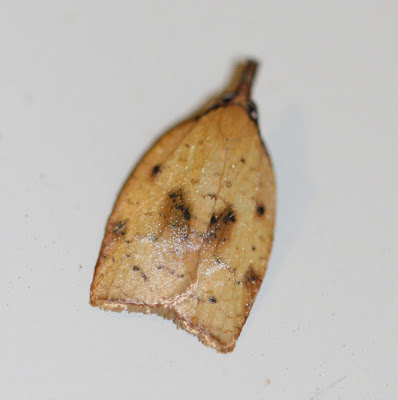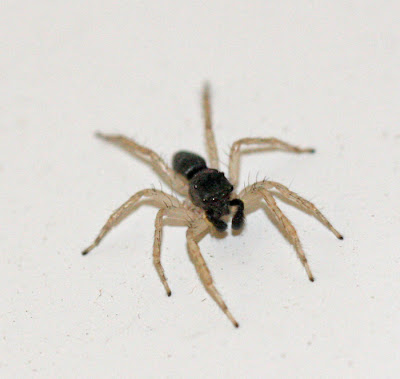This disorientation and movement towards the light (not technically "attraction") allows close observation of many insects species that would be difficult to find otherwise. For the past week or so, I have been going out to the porch light after dark and checking to see what shows up. Over the course of about one week, I have recorded about 60 species of moths near the light, as well as numerous species of other insects including mayflies, wasps, beetles, and stink bugs.
 A common moth species this time of year is the Pink-barred Pseudeustrotia (Pseudeustrotia carneola). This species is easily recognized by the two light-colored bands that break up the dark areas of the wing.
A common moth species this time of year is the Pink-barred Pseudeustrotia (Pseudeustrotia carneola). This species is easily recognized by the two light-colored bands that break up the dark areas of the wing. Unlike the previous species, the Common Idia (Idia aemula) is a fairly plain species. This is a very light-colored individual.
Unlike the previous species, the Common Idia (Idia aemula) is a fairly plain species. This is a very light-colored individual. Moths come in many shapes, sizes, and colors. This Grape Leaf-folder Moth (Desmia sp.) is a relatively small moth, with a wingspan of about 2 cm and a distinctive shape and pattern.
Moths come in many shapes, sizes, and colors. This Grape Leaf-folder Moth (Desmia sp.) is a relatively small moth, with a wingspan of about 2 cm and a distinctive shape and pattern. This yellow moth, Sparganothis xanthoides, is one of many species of moths that I had never encountered before.
This yellow moth, Sparganothis xanthoides, is one of many species of moths that I had never encountered before. As the name would suggest, the large Tulip-tree Beauty (Epimecis hortaria) is a gorgeous moth.
As the name would suggest, the large Tulip-tree Beauty (Epimecis hortaria) is a gorgeous moth. Another aptly named moth is the Beautiful Wood-Nymph (Eudryas grata). The beautiful patterns and colors on this moth made it stand out from many of the brown and gray species at the light.
Another aptly named moth is the Beautiful Wood-Nymph (Eudryas grata). The beautiful patterns and colors on this moth made it stand out from many of the brown and gray species at the light. This Leuconycta diphteroides is rather dull, but if you look carefully, the wings have very interesting patterns.
This Leuconycta diphteroides is rather dull, but if you look carefully, the wings have very interesting patterns. Although this moth appears very different from the previous picture, this is another
Although this moth appears very different from the previous picture, this is another Leuconycta diphteroides. This one is much brighter and more colorful, so the patterns really stand out.
 Most of the previously mentioned moths are relatively large and easy to see as they sit on the edge of the house. However, some moths require a bit of searching because their small size makes them difficult to find. One example of such a moth is this Diamondback Moth (Plutella xylostella), which has a wingspan of about one centimeter. Although hard to imagine, this species is a well-documented transoceanic migrant!
Most of the previously mentioned moths are relatively large and easy to see as they sit on the edge of the house. However, some moths require a bit of searching because their small size makes them difficult to find. One example of such a moth is this Diamondback Moth (Plutella xylostella), which has a wingspan of about one centimeter. Although hard to imagine, this species is a well-documented transoceanic migrant! The Speckled Xylesthia Moth (Xylesthia pruniramiella) is another small moth that blended in with the wall on which it was perched. This species has distinct "ridges" on the top of its wings.
The Speckled Xylesthia Moth (Xylesthia pruniramiella) is another small moth that blended in with the wall on which it was perched. This species has distinct "ridges" on the top of its wings. The Double-banded Grass-Veneer (Crambus agitatellus) is the most common small moth at the porch light this time of year. This species is also commonly found in the woods and meadows near the house.
The Double-banded Grass-Veneer (Crambus agitatellus) is the most common small moth at the porch light this time of year. This species is also commonly found in the woods and meadows near the house. Plenty of non-moth insects come to the light as well. This stinkbug, Banasa calva, is a species that I have only ever seen around lights at night.
Plenty of non-moth insects come to the light as well. This stinkbug, Banasa calva, is a species that I have only ever seen around lights at night. While many of the moths come to the light for the reason mentioned at the beginning of this post, this Dimorphic Jumping Spider (Maevia inclemens) came to the light to find an easy snack.
While many of the moths come to the light for the reason mentioned at the beginning of this post, this Dimorphic Jumping Spider (Maevia inclemens) came to the light to find an easy snack. This Ichneumon wasp in the genus Netelia is only one of several wasps that I see at the porch light each evening.
This Ichneumon wasp in the genus Netelia is only one of several wasps that I see at the porch light each evening.

1 comment:
My Uncle passed away making a field guide to the moths of Maryland. Maybe this could be a project for you for your area. It's a wide open topic possibly.
Post a Comment